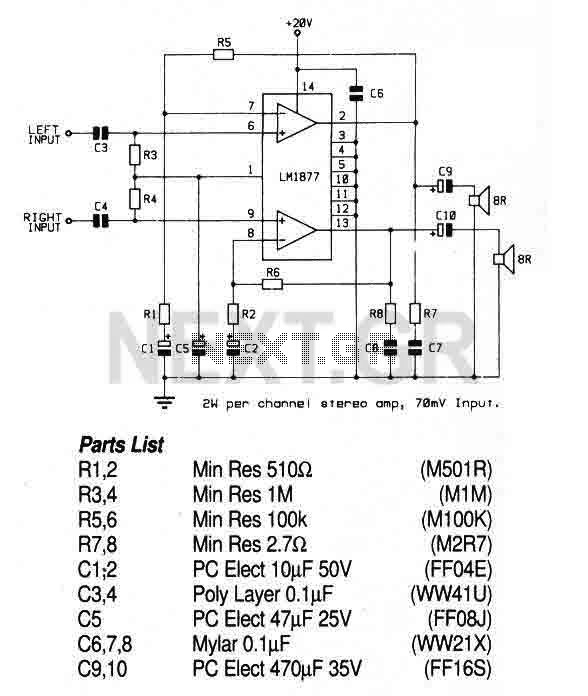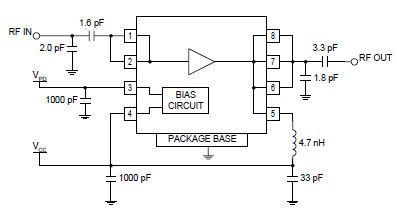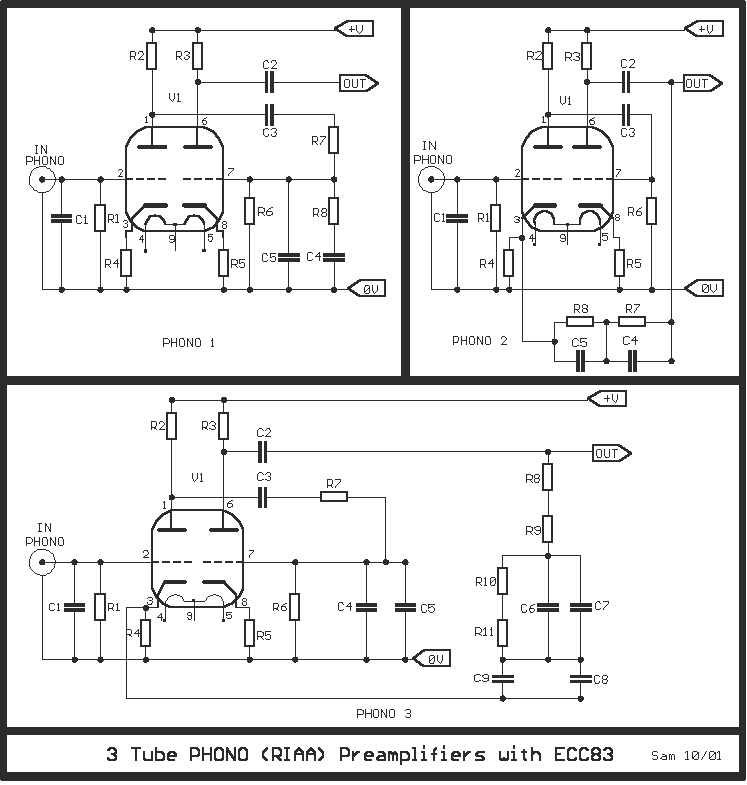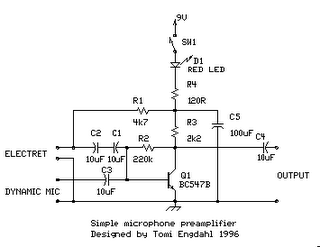
2 Watt stereo amplifier with LM1877N-9

This circuit employs a stereo amplifier integrated circuit (IC) housed in a 14-pin dual in-line package (DIL). It necessitates minimal external components to create a complete 2-watt per channel power amplifier. The LM1877N-9 is appropriate for use with 8-ohm or 16-ohm speakers.
The circuit design utilizing the LM1877N-9 stereo amplifier IC is optimized for efficiency and simplicity, making it an ideal choice for compact audio applications. The LM1877N-9 is a high-performance amplifier that provides a robust output of 2 watts per channel, suitable for driving small to medium-sized speakers effectively.
Key features of the LM1877N-9 include its ability to operate with both 8-ohm and 16-ohm speaker loads, allowing for versatility in speaker selection based on application requirements. The amplifier's design minimizes the need for external components, which not only simplifies the assembly process but also reduces the overall footprint of the circuit.
In the typical application, the circuit would include power supply connections, input signal connections, and output connections to the speakers. The power supply should be designed to match the voltage requirements of the LM1877N-9, ensuring stable operation. Additionally, decoupling capacitors may be suggested at the power supply pins to filter out noise and stabilize the voltage supply.
Input signals can be fed into the amplifier through a pair of input capacitors, which serve to block any DC offset from the audio source, ensuring that only the AC audio signal is amplified. The output stage of the amplifier connects directly to the speakers, with the design allowing for straightforward wiring.
Thermal management considerations should also be addressed, as the LM1877N-9 may generate heat during operation. Adequate ventilation or the addition of a heat sink may be necessary to maintain optimal operating temperatures and prevent thermal shutdown.
Overall, the circuit provides an efficient and straightforward solution for audio amplification in various applications, from portable devices to small home audio systems, making it a valuable design for engineers seeking reliable audio performance with minimal complexity.This circuit uses a stereo amplifier IC in a 14-pin DIL package that requires very few external components to make a complete 2 Watt per channel power amplifier. The LM1877N-9 is suitable for use with 8ohm or 16ohm speakers.
The circuit design utilizing the LM1877N-9 stereo amplifier IC is optimized for efficiency and simplicity, making it an ideal choice for compact audio applications. The LM1877N-9 is a high-performance amplifier that provides a robust output of 2 watts per channel, suitable for driving small to medium-sized speakers effectively.
Key features of the LM1877N-9 include its ability to operate with both 8-ohm and 16-ohm speaker loads, allowing for versatility in speaker selection based on application requirements. The amplifier's design minimizes the need for external components, which not only simplifies the assembly process but also reduces the overall footprint of the circuit.
In the typical application, the circuit would include power supply connections, input signal connections, and output connections to the speakers. The power supply should be designed to match the voltage requirements of the LM1877N-9, ensuring stable operation. Additionally, decoupling capacitors may be suggested at the power supply pins to filter out noise and stabilize the voltage supply.
Input signals can be fed into the amplifier through a pair of input capacitors, which serve to block any DC offset from the audio source, ensuring that only the AC audio signal is amplified. The output stage of the amplifier connects directly to the speakers, with the design allowing for straightforward wiring.
Thermal management considerations should also be addressed, as the LM1877N-9 may generate heat during operation. Adequate ventilation or the addition of a heat sink may be necessary to maintain optimal operating temperatures and prevent thermal shutdown.
Overall, the circuit provides an efficient and straightforward solution for audio amplification in various applications, from portable devices to small home audio systems, making it a valuable design for engineers seeking reliable audio performance with minimal complexity.This circuit uses a stereo amplifier IC in a 14-pin DIL package that requires very few external components to make a complete 2 Watt per channel power amplifier. The LM1877N-9 is suitable for use with 8ohm or 16ohm speakers.





